Up close photomosaic view shows lengthy tear in rover Curiosity’s left front wheel caused by recent driving over sharp edged Martian rocks on the months long trek to Mount Sharp. The team is evaluating an alternate, smoother way forward to next science target. Raw images taken by the MAHLI camera on Curiosity’s arm on Jan. 31, 2014 (Sol 529) were assembled to show some recent damage to several of its six wheels.
Credit: NASA / JPL / MSSS / Marco Di Lorenzo / Ken Kremer- kenkremer.com
See below complete 6 wheel mosaic and ‘Dingo Gap’ dune alternate route mosaic plus 3-D view[/caption]
Continuing wheel damage from hoards of sharp edged Martian rocks are forcing engineers to seek a smoother pathway forward – potentially through a treacherous dune field – for NASA’s Curiosity rover on the jagged rock strewn road to Mount Sharp, her primary science destination.
Ever since rover engineers noticed holes and tears to the robots six aluminum wheels this past fall and winter 2013, the team has been photographing the wheels much more frequently and carefully assessing their condition. See our mosaics above and below.
Curiosity’s handlers are now considering diverting the SUV-sized robot to an alternate path crossing into a dune field and the valley beyond that entails traversing through much smoother Martian terrain to reach a highly desirable and nearby science destination called “KMS-9.”
Newly received images taken by the robot only on Friday, Jan. 31, reveal a very significant ragged looking puncture at least 2 to 3 inches (5 to 8 cm) in length and a inch or so (3 cm) wide that’s bent back to the inside of the left front wheel.
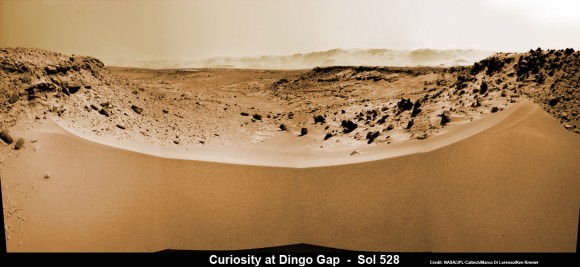
This photomosaic from Curiosity’s Navigation Camera (Navcam) taken at the edge of the entrance to the Dingo Gap shows a 3 foot (1 meter) tall dune and valley terrain beyond to the west, all dramatically back dropped by eroded rim of Gale Crater. View from the rover’s current position on Sol 528 (Jan. 30, 2014). The rover team may decide soon whether Curiosity will bridge the dune gap as a smoother path to next science destination. Credit: NASA/JPL-Caltech/Marco Di Lorenzo/Ken Kremer- kenkremer.com
See NASA’s 3-D view of Dingo Gap below
Unfortunately, the fields of rough Red Planet rocks have not been a blessing to the 1 ton behemoth.
See our new underbelly mosaic view of Curiosity’s holy wheels (above and below) snapped on Jan. 31, (Sol 529), that’s aimed at the interior and which vividly shows the extent of the injury to the 20 inch diameter wheel.

The rate of wheel damage has picked up dramatically as the driving pace accelerated across the rugged, rock filled Martian terrain over the past six months and put over 4.89 kilometers (3.04 mi.) on the odometer to date since the nailbiting August 2012 landing.
The mega robot is now standing at the edge of the dune field by the picturesque entrance known as the “Dingo Gap” after driving another 865 feet (264.7 meters) during January 2014.
You can see the increased damage resulting from the past months drive by comparing the new Sol 529 view with our underbelly mosaic from Sol 490 in December 2013.
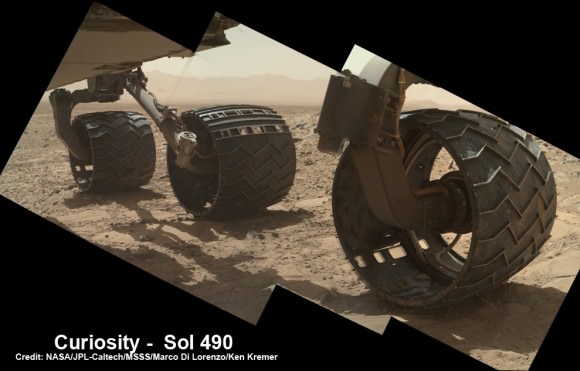
However, the dune cutting across “Dingo Gap” measures about 3 feet (1 meter) in height.
Look at this 3-D “Dingo Gap” mosaic view from NASA and you can judge for yourself the choices the team faces.
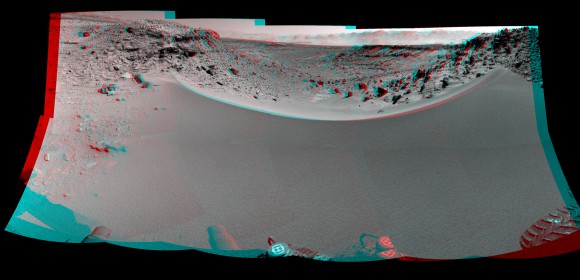
This stereo mosaic of images from the Navigation Camera (Navcam) on Curiosity shows the terrain to the west from the rover’s position on Sol 528 (Jan. 30, 2014). The scene appears three dimensional when viewed through red-blue glasses with the red lens on the left. The view was taken just after Curiosity had arrived at the eastern edge of a location called “Dingo Gap.” A dune across the gap is about 3 feet (1 meter) high in the middle and tapered at south (left) and north (right) ends onto low scarps on either side of the gap. The rover team is evaluating possible driving routes on the other side before a decision whether the cross the gap. Credit: NASA/JPL-Caltech
So the team is evaluating whether that’s safe to bridge because they don’t want to get stuck in a hidden sand trap like the one that ultimately led to Spirit’s demise a few years back.
“The decision hasn’t been made yet, but it is prudent to go check,” said Jim Erickson of NASA’s Jet Propulsion Laboratory, Pasadena, Calif., project manager for Curiosity, in a NASA statement.
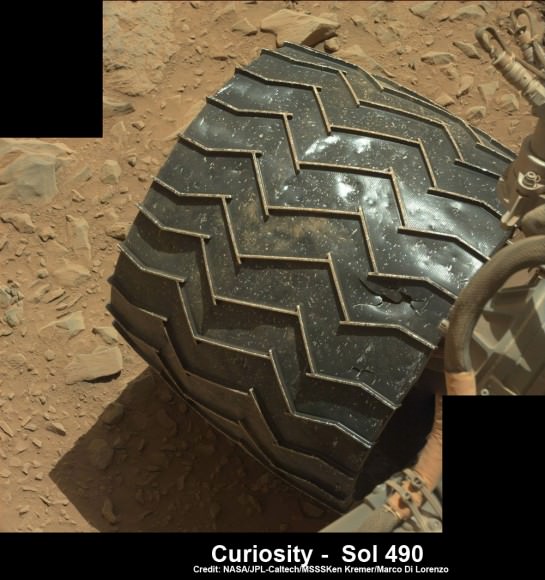
“We’ll take a peek over the dune into the valley immediately to the west to see whether the terrain looks as good as the analysis of orbital images implies,” Erickson added, based on orbital images snapped by the High Resolution Imaging Science Experiment (HiRISE) camera on NASA’s Mars Reconnaissance Orbiter (MRO) circling overhead.
The team is also testing an array of different driving techniques to minimize the accumulation of wheel punctures, such as driving backwards or using only four of the six wheels to reduce the force of the wheels pushing against jagged rocks.
The “Dingo Gap” could offer a safer gateway to “KMS-9” along the journey of the rovers southwestwardly route to breathtaking foothills of Mount Sharp.

Dingo Gap lies between two low scarps and that is tapered off at both sides to the north and south.
KMS-9 is a potentially science rich target where the team hopes to conduct the first rock drilling operations since departing the Yellowknife Bay quadrant in July 2013.
The candidate drilling site lies only about half a mile (800 meters) away as the martian crow flies and features geology that’s appealing to the science team. But the roving routes under consideration are all much farther in actual distance.
“At KMS-9, we see three terrain types exposed and a relatively dust-free surface,” said science team collaborator Katie Stack of the California Institute of Technology, Pasadena.
Curiosity has already accomplished her primary goal of discovering a habitable zone on Mars that could support Martian microbes if they ever existed.
NASA’s rover Curiosity uncovered evidence that an ancient Martian lake had the right chemical ingredients, including clay minerals that could have sustained microbial life forms for long periods of time – and that these habitable conditions persisted on the Red Planet until a more recent epoch than previously thought.
As a result, the science team has shifted the missions focus to include the search for organic molecules – the building blocks of life as we know it – which may be preserved in the sedimentary rock layers of Mount Sharp.
“Really what we’re doing is turning the corner from a mission that is dedicated to the search for habitable environments to a mission that is now dedicated to the search for that subset of habitable environments which also preserves organic carbon,” Curiosity Principal Investigator John Grotzinger, of the California Institute of Technology in Pasadena, said recently at the Dec. 2013 annual meeting of the American Geophysical Union (AGU).
Meanwhile, NASA’s Opportunity rover is exploring clay mineral outcrops by the summit of Solander Point on the opposite side of the Mars at the start of her 2nd Decade investigating the Red Planets mysteries.
Read my new story about the Top 10 Decade 1 discoveries of Spirit and Opportunity – here.
And a pair of new orbiters are streaking to the Red Planet to fortify Earth’s invasion fleet- NASA’s MAVEN and India’s MOM.
Finally, China’s new Yutu moon rover is hibernating through her 2nd lunar night as we await word of her fate next weekend, around Feb 8 or 9.
Stay tuned here for Ken’s continuing Curiosity, Opportunity, Chang’e-3, SpaceX, Orbital Sciences, LADEE, MAVEN, MOM and Mars news.
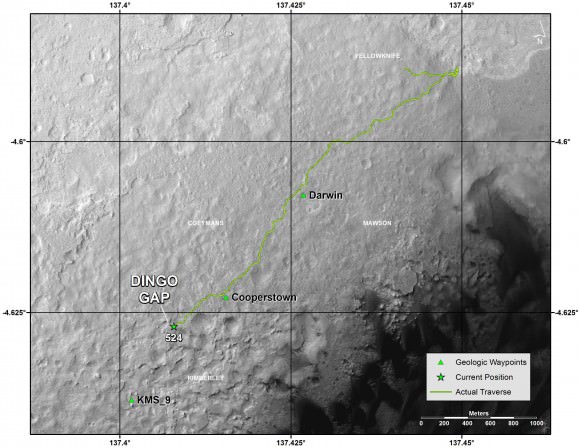
Credit: NASA/JPL-Caltech

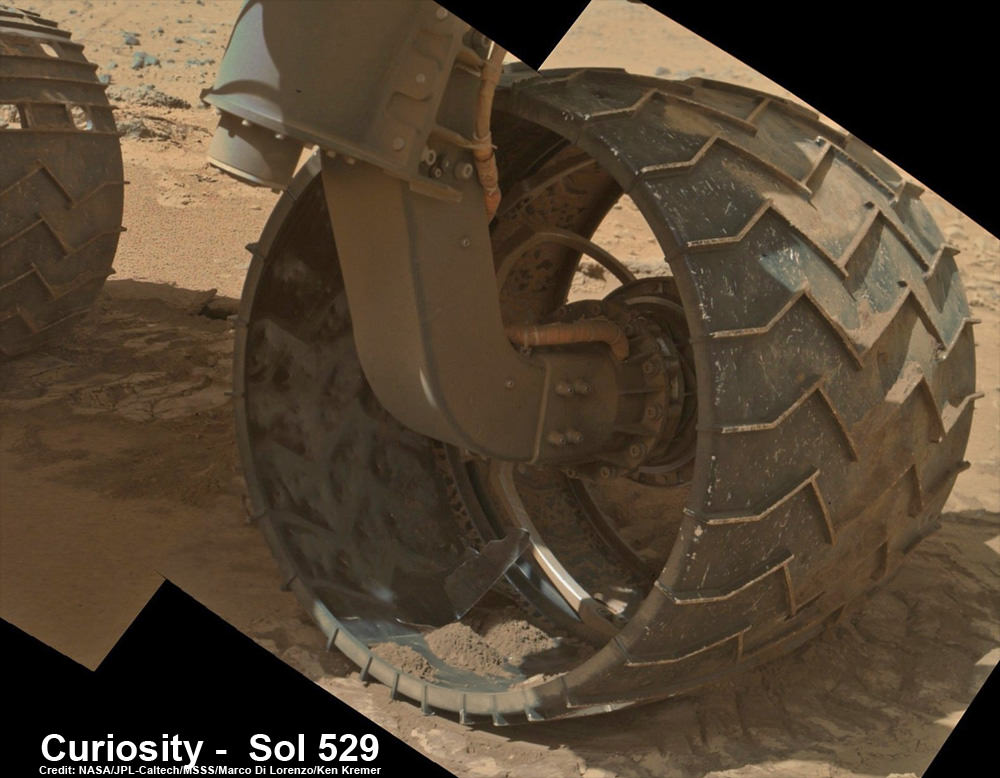
Curiosity’s wheel design is right up there with Oppy and Spirit not having a way to clear their solar panels? Ahem… in 20-20 hindsight it might have been better if the wheels had been coated with a reinforced ‘rubber-like’ tread layer? Lessee 2,000 lbs/6 = avg. 330 lbs load on each wheel… But that’s on Earth. On Mars the rover weighs 800 lbs or 133 lbs per wheel.
Rubber turns brittle when it gets too cold and Mars is definitely cold enough. Solar panel dust is not a serious problem for the MERs especially given that the mission was designed to last three months and has gone on for ten now. They also knew MSL’s wheels would become dented, penetrated, and perhaps even ovalized (their word, not mine). This is all part of the plan although I think they may be deteriorating a bit faster than anticipated. Anyway, much respect to the scientists and engineers who devoted years of work to all these rovers.
Ten years, that is. Yup, not being able to edit mistakes kinda sucks. 🙂
I am surprised that this problem could not be detected during tests on Earth, well before sending such a sophisticated (and heavy) rover to Mars.
Agreed, I don’t understand how such an ambitious and expensive rover could have passed testing with wheels that are showing so much wear after only three miles. With all the modern materials available for construction, why make them out of what seems to be glorified soda cans?
What kind of life can we expect from these wheels before they wear to the point the rover becomes incapable of movement?
In fact this was in the design specs. In other words they knew this was going to happen and decided it was ok.
“Wheel cleats and surfaces thoroughly tested for odometry, wheel impact, functionality – localized denting & rupture, ovalization permitted”
Why is it ok? It was the best they could do within weight limits. They want science equipment on board, not tank treads.
I’m sure the designers had to work within certain design constraints, but skimping on the wheels seems penny-wise, pound-foolish. This rover is equipped with an RTG similar to that used to power the Voyager space craft and could conceivably run for decades. It would be a real shame if the rover became immobilized due to damaged wheels while it still had power and an operational science platform.
What is that wheel made out of? It looks like some kind of flimsy cheap slippery plastic. It looks different in the three top photos, but in the close up photo it looks shiny. Also it looks like there’s a nail in the tire.
“Also it looks like there’s a nail in the tire.”
Delete that. It’s just a chip, clarified in the enlargement (can’t edit, huh?). Still, that tire material looks thinner and weaker than most of the doodads I buy at the Walmart come wrapped in.
The tires look like thin brittle plastic. So then each is supporting 133 pounds per wheel. Compare that with the bicycle tires you’d use to support a huge man on rough terrain. Google mountain bike tires. You can’t make mountain bike tires out of some thin brittle material. Something doesn’t compute here.
They’re made of aluminum. Plastic or rubber would have become very very brittle due to the cold conditions during the night on Mars (day time can get up to 20C during the summer at the equator, and can break 0C where Curiosity is, but the night often gets down below -60C in that area).
Living in Canada I can tell you that most of our tech doesn’t work well in the cold. For instance, all the cars designed in balmy California, Korea, and Japan work like absolute crap up here, and it doesn’t get anywhere near as cold as it does on Mars. I’m not sure if it is because engineers living in California are too stupid to know that their vehicles will have to work in the cold (even Detroit doesn’t get very cold most years), or whether they’re running up against limits in our technology, but either way everything from consumer telescopes to cars to phones have trouble here. And it’s only -14C as I type this:P.
(I took astronomy lab courses years ago in university, and the grad students had to modify all our telescopes to work properly here:P. You guessed it, all designed in California!)
Why do the tires have a rugged matte appearance, except in the closeup photo at the bottom where they appear to be made of a different material, shiny and plastic? They don’t look like aluminum there, the sheen, the way they cracked, the striations.
As for the engineers being too stupid to think of the cold on Mars, c’mon, compared with everything else involved here, that is sub-kindergarten stuff – “Duh, let’s put strong enough tires on it that will work good on Mars!”
It does really seem that there has been a lapse of judgement somewhere along the way when these “aluminum cans” were produced. I do understand the mass constraints, but this is a $2.5 billion vehicle running on an other planet! The power supply should be good for more than 10 years of operation, so why make the wheels so weak they start to fall apart even before the main science goal is reached? I hope a software fix to the driving algorithm can reduce the wheel wear (by avoiding even those small rocks). It would truly be a shame if this machine got stuck because of a “flat tire”.
of course leaves one to wonder if ~2 mm aluminum in between reinforcements is strong enough to support that weight over sharp rocks. I hope there was at least one team member who said “guys! come on this is so stupid!” when someone started trying to convince the team to do it… we can only hope that it can truly work in an absolutely skeletonized form.
b t dubs, i think these wheels look awesome 🙂 and i hope this rover goes and goes and goes!
I still don’t know why the wheel in the top picture looks like a perfectly rugged functional wheel with plenty of “tread” on it, but in the bottom picture it looks like a shiny dinky toy.
The mass constraint must have been very tight. I bet the engineers would have preferred to use Titanium which is 1.67 x the mass of Aluminium for the same volume but has (roughly) twice the tensile strength (depends on the grade of aluminium used.) There may be other considerations though (heat conductance?) However, given that they expected this sort of damage I have no reason to think this will be a show-stopper.
“given that they expected this sort of damage…”
Say what!?
How hard is it to build a strong lightweight wheel – compared with going to Mars!?
A lot of this isn’t making sense.
the reason for the fragility of the wheels comes from the fact that the wheels are Voronin made ??of aluminum, for the simple reason of mass at the time of planning the sky crane element could only make a safe descent to a ton of weight but if they placed stronger and safer wheels would have an excess of mass, perfriro care instruments and reduce the weight on the wheels.
What’s that, doubletalk?
Is there a NASA forum where I can get a rational response to these questions? Because – along with that mysterious object that appears to be a blob of solder that fell on the ground that they are calling “martian jelly donut” – I wouldn’t want to think that this is all some gag on a movie set – because it does not make sense!